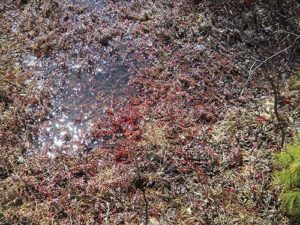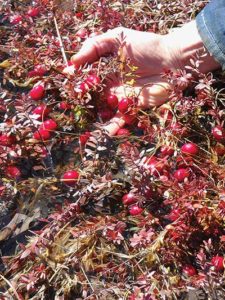 |
| Many Maine farms and homesteads have low spots where cranberries will do well. |
 |
| Cranberries ready for harvest |
By Will Bonsall
Most folks think of cranberries as a crop with requirements that are too challenging for their situation. Cranberries like sandy, acidic, soggy peat soils that can be flooded at will, whereas the average gardener has (or aspires to have) a well-drained, marl, near-neutral soil with sufficient nitrogen-containing humus. Cooperative Extension sources say that cranberries need a glacial deposit consisting of clay underlying gravel underlying peat underlying sand, or you have to create those conditions by building such layers yourself.
An Adaptable Crop
I’m sure that’s what cranberry plants prefer, but I’ve found that the crop is not quite that picky. Many years ago a friend gave me some plants he’d gotten from the state, and I looked for an appropriate place to try them. Our hay field had a slight low spot where thatch always accumulated due to excess water that impeded the decay of each year’s grass growth. The area wasn’t that special; I bet most of you have such a spot. This was hardly a “bog,” but I enhanced the effect by digging out the sod (with most of the topsoil) and shaping it around the area to exaggerate the depression. That left the remaining subsoil sterile, which was rocky and prone to waterlogging – in short, just right. I left a shallow ditch draining the area so that I could retain or remove surplus water as desired, although I never bothered to close the ditch. There were lots of rocks, and I removed most of them, at least the larger ones, but to no great depth. It’s been a long time, and I don’t remember how well I worked the “ground” (“soil” is a bit too kind), but I don’t recall doing much.
I will point out that I’ve never been exceptionally fond of cranberries. I just like growing some of everything, and my wife appreciated that they promoted bladder health (more on that later). Since they’ve begun to yield, she finds that she’s off them, so I’m trying to develop a taste for them myself, with considerable success.
Surviving Neglect
I didn’t have much confidence in growing cranberries in my upland, very-un-Cape-Cod-like soil, but I had the plants, so there. They were rather wispy little rooted runners, and I guessed at a spacing of about 2 feet square. I may have returned to cultivate them once or twice, but if so I wasn’t very thorough – so not surprisingly the little plot grew up to alders and gray birch and lots of scruffy weeds that almost obscured the cranberry plants. Many died, and indeed I wasn’t sure any had survived, so haphazard was my attention. The plants are very low and sprawling, and their teeny leaves are easy to overlook, which I did for several years.
Then one fall I happened to notice a few half-hidden berries among the skimpy grey-green vines – beautiful full-sized berries that looked almost out of place amid that weedy mess. Only then did I notice that some sections were blanketed with a solid mat of plants, with most of the fruit beneath. This was not a bodacious crop, but quite respectable considering its neglect. Since then I’ve cut out most of the brush and done some cursory weeding. The plants appreciated it, and the weedy gaps are filling in quickly. I helped a little by thinning some spots and transplanting a few of the runners where they quickly took off.
What I have not done is what cranberries supposedly need for success: I have never flooded or drained them, just let them be. My ground isn’t perfectly level but has some slight humps and hollows, which the cranberries don’t seem to mind much. Conventional cranberry growers flood their “bogs” twice a year: first to protect the forming fruit from the false armyworm and other pests (which I have yet to see, but then I’m not on Cape Cod), and at harvest time to float the ripe berries for machine harvesting (I hand pick mine, which suits my purpose). Commercial growers spread a layer of sand on the ice in winter, which in spring sinks to the bottom to mulch out weeds. Again, I do a bit of hand weeding, which is adequate for my noncommercial operation.
Despite all I’ve said, growing cranberries is not right for everyone, or at least not for every soil. They definitely do not abide heavy clay soil, nor overly dry soil. Although they tolerate flooding, they don’t want to be constantly waterlogged. Fertility doesn’t seem to be a big issue; mine certainly aren’t over-nourished. No doubt they would like a bit more humus than the sterile subsoil I put them into, but I believe too much nitrogen would pose a greater threat, as it would encourage ranker growth, which would choke them out. They seem to prefer a leaner lot with neighbors they can compete with.
We think of cranberries ripening just in time for the holidays, but I was shocked to discover berries left over winter, under snow and some under water, in perfectly good condition the following April. I’m sure they grow back quickly once the weather warms, but I’m grateful for a second chance at whatever I may have missed. I remember reading about the early Puritans shipping cranberries to England in casks of pure cold water, where they keep well for weeks or months.
Adaptable, to a Point
Cranberries (Vaccinium macrocarpum) are closely related to a species in northern Europe. All belong in the Ericaceae, or heath family, along with blueberries, huckleberries, bilberries, lingonberries or wortleberries (no, I never did either …), all well-adapted for acid peat soils.
Could cranberries grow in common garden soil? I don’t know, but I’m skeptical. As mentioned before, the high fertility would create much greater weed pressure without helping the cranberries in proportion. Maintaining a sufficiently low pH would require adding sulfate or something (pine needles?). Like most Maine soils, my patch is naturally rather acidic; for cranberries, I mainly have to avoid adding any alkali. Without the occasional standing water, I expect the roots would feel ill at ease, whether they’d actually tolerate that condition or not. What I do know is that if you can find or create the right conditions, you’ll have little need for further maintenance, as shown by my cruelly neglected patch.
Ornamental and Consumable
I’ve never known anyone to mention this, but while cranberry plants look pretty nondescript, the berries themselves are quite ornamental. Their different shades of glossy dark red with occasional yellowish blushes on the unlit side give a dramatic accent to reeds and such. I just like to leave a wooden bowlful sitting on the table – although in warm, dry air they soon wither, at which point you should throw them into the sauce pan right away. No matter; sooner or later they’re meant to be eaten.
About eating: Plain cranberry sauce is the classic, and in my opinion the best way to prepare and eat theses tart northern delicacies. Just cover them with water and simmer slowly, sweetening to taste toward the end. I’m not sure how commercial cranberry juice is made, but I’ve more than covered the berries with water and simmered them long and slowly (partly to bring out the color) before hanging them overnight in a juice bag. (An old pillowcase will do; of course it could be a new one too.) Some might like the juice that way, sweetened I assume; I care for it only when mixed at least half-and-half with late fall apple juice.
Cranberries have a reputation for being healthy, and they are, but the story is not so simple. They may lower “bad” (LDL) cholesterol and enhance the balance of “good” (HDL) cholesterol. Their high polyphenol content (associated with the rich color) helps prevent cardiovascular disease. They are also high in vitamins C, E and K1, along with the minerals copper and manganese. (“Cranberries 101: Nutrition Facts and Health Benefits,” by Atli Arnarson, Ph.D., healthline, Feb. 15, 2019; https://www.healthline.com/nutrition/foods/cranberries)
As for their bladder-friendliness, here’s where it gets complicated. In “Hold the cranberries: UTI myths explained,” Courtenay Moore, M.D., a urologist at the Cleveland Clinic, is cited as saying that some initial studies seemed to indicate no significant beneficial effect of cranberry juice on resolving urinary tract infections (UTIs). (Chicago Tribune, Jan. 28, 2015; https://www.chicagotribune.com/lifestyles/health/sns-201501270000–tms–premhnstr–k-h20150128-20150128-story.html) Follow-up investigations suggest that doses that are too small are ineffectual, but a few glasses per day, every couple of hours (preferably unsweetened), can prevent UTIs. This is because A-type proanthocyanidins in cranberry juice prevent the E. coli bacteria that cause UTIs from sticking to the urinary tract walls, including the bladder. Note that “prevents” is different from “curing” established UTIs. In fact, according to Susun Weed, cranberry juice can aggravate interstitial cystitis, a condition causing bladder pressure, bladder pain and sometimes pelvic pain. (“Interstitial cystitis,” by Susun Weed, Wise Woman Herbal Ezine, May 2008; https://www.susunweed.com/herbal_ezine/May08/grandmother.htm)
Varieties and Sources
Three of the most common cranberry varieties are ‘Early Black’, ‘Howes’ and ‘Stevens’. I believe mine are ‘Stevens’. I think the main differences are color, size and earliness, but I don’t know enough to have a preference. More recently developed varieties include ‘Crimson Queen’, ‘Valley King’ and ‘Granite Red’.
Commercial sources include Cape Cod Select in Carver, Mass., Willows Cranberries in Wareham, Mass., and Pine Barrens Native Fruits LLC in Browns Mills, New Jersey. Home gardeners can check Fedco Trees, which offers ‘Stevens’. Cranberry Creations of Mt. Vernon, Maine, sells plants both wholesale and retail. See https://cranberrycreations.com/.
About the author: Will Bonsall lives in Industry, Maine, where he directs Scatterseed Project (https://www.scatterseedproject.org/#scatterseed), a seed-saving enterprise. He is the author of “Will Bonsall’s Essential Guide to Radical Self-Reliant Gardening” (Chelsea Green, 2015). You can contact him at [email protected].
This article is for informational purposes only. For serious health issues, please contact your health care practitioner.
